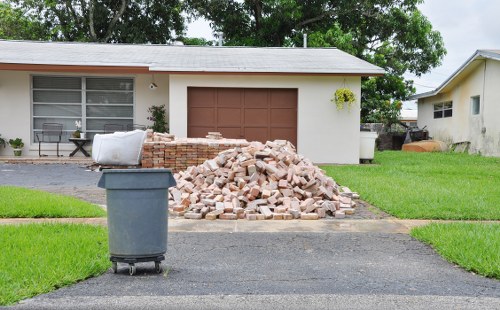Effective Furniture Disposal in Commercial Waste Management

In the realm of **commercial waste disposal**, furniture disposal stands out as a critical task that requires careful planning and execution. Businesses regularly update their office spaces, stores, and other commercial environments, leading to the accumulation of old or unwanted furniture. Proper disposal is not only a matter of maintaining a clean and organized workspace but also essential for adhering to environmental regulations and sustainability practices. This article delves into the various aspects of furniture disposal within commercial waste management, offering insights and strategies to handle this process efficiently.
Furniture disposal in commercial settings encompasses a wide range of items including desks, chairs, cabinets, and other office furnishings. Each piece of furniture poses unique challenges, from the materials used in their construction to the potential for recycling or resale. Effective disposal mechanisms can significantly reduce the environmental footprint of a business while also freeing up valuable space and resources.
Understanding the importance of **sustainable waste management** can guide businesses in making informed decisions about furniture disposal. By prioritizing eco-friendly methods, companies not only comply with legal standards but also enhance their corporate social responsibility profiles. This, in turn, can improve their reputation among clients, partners, and the broader community.

Why Proper Furniture Disposal Matters
Proper furniture disposal is crucial for several reasons:
- Environmental Protection: Disposing of furniture responsibly helps reduce landfill waste and minimizes the impact on the environment.
- Legal Compliance: Many regions have strict regulations concerning waste disposal, and non-compliance can result in hefty fines.
- Cost Efficiency: Efficient disposal methods can save businesses money by reducing waste management costs and potentially generating revenue through resale or recycling.
- Space Optimization: Removing old furniture frees up space, allowing businesses to operate more efficiently and create a better working environment.
Addressing these factors ensures that businesses maintain their operational integrity while contributing positively to environmental sustainability.
Moreover, the trend towards remote work and flexible office spaces has increased the need for adaptable and efficient furniture disposal solutions. As businesses evolve, so do their waste management requirements, making it essential to stay informed about the latest practices and technologies in furniture disposal.

Methods of Furniture Disposal
There are several methods available for disposing of commercial furniture, each with its own set of advantages and considerations:
1. Recycling
Recycling is one of the most environmentally friendly methods of furniture disposal. It involves breaking down furniture materials to be reused in the manufacturing of new products.
- Advantages: Reduces environmental impact, conserves natural resources, and often complies with regulatory standards.
- Considerations: Not all materials are recyclable, and the process can be labor-intensive.
2. Resale
Reselling furniture is a viable option for items that are still in good condition. This can be done through second-hand stores, online marketplaces, or auction sites.
- Advantages: Generates revenue, extends the lifecycle of furniture, and reduces waste.
- Considerations: Requires time and effort to list and sell items, and the resale value may vary.
3. Donation
Donating furniture to charitable organizations or non-profits can be a meaningful way to dispose of unwanted items while supporting the community.
- Advantages: Provides social benefits, may offer tax deductions, and reduces landfill waste.
- Considerations: Organizations may have specific requirements, and pickup schedules may be limited.

Steps to Efficient Furniture Disposal
To ensure an effective furniture disposal process within a commercial context, businesses should follow these key steps:
- Inventory Assessment: Conduct a thorough inventory of all furniture items to determine their condition and the appropriate disposal method.
- Planning: Develop a disposal plan that includes timelines, responsibilities, and selected disposal methods.
- Compliance Check: Ensure that the chosen disposal methods comply with local regulations and environmental standards.
- Execution: Implement the disposal plan, coordinating with recycling centers, resale platforms, or donation organizations as needed.
- Documentation: Keep records of disposed items, including details of transactions, donations, or recycling processes for accountability and regulatory purposes.
By following these steps, businesses can streamline their furniture disposal process, minimizing disruptions and maximizing benefits.
Additionally, involving employees in the disposal process can enhance efficiency and ensure that all items are accounted for and disposed of appropriately. Clear communication and defined roles can prevent misunderstandings and facilitate a smoother transition.

Choosing the Right Disposal Partner
Selecting a reliable waste disposal partner is pivotal for effective furniture disposal. A professional partner can offer expertise, resources, and tailored solutions to meet the specific needs of your business.
Factors to Consider:
- Reputation: Research the company's track record and customer reviews to ensure reliability and quality of service.
- Services Offered: Ensure that the disposal partner provides the services you require, such as recycling, resale, or donation facilitation.
- Cost: Compare pricing structures to find a cost-effective solution without compromising on service quality.
- Compliance: Verify that the partner adheres to all relevant regulations and environmental standards.
- Flexibility: Choose a partner that can accommodate your schedule and any unique requirements your business may have.
Building a strong relationship with a disposal partner can lead to more efficient processes and better outcomes, ensuring that your furniture disposal needs are met seamlessly.
Moreover, a reputable disposal partner can provide valuable insights and recommendations, helping your business implement sustainable practices and enhance its waste management strategies.

Environmental Impact of Improper Disposal
Improper furniture disposal can have significant negative effects on the environment. When furniture ends up in landfills, it contributes to soil and water pollution, and the decomposition of certain materials can release harmful chemicals.
- Landfill Overload: Furniture takes up considerable space in landfills, accelerating the need for new landfill sites.
- Pollution: Materials like plastics, metals, and treated wood can leach toxins into the soil and waterways.
- Resource Wastage: Disposing of furniture without recycling or reuse means losing valuable resources that could be repurposed.
Understanding these impacts underscores the importance of responsible disposal methods. Businesses can play a significant role in mitigating environmental damage by adopting sustainable waste management practices.
Additionally, consumers are increasingly aware of environmental issues, and their preferences can influence businesses to adopt greener practices. Companies that prioritize eco-friendly disposal can enhance their brand image and attract environmentally conscious clients.

Benefits of Sustainable Furniture Disposal
Embracing sustainable furniture disposal offers numerous benefits to businesses and the environment:
- Cost Savings: Recycling and resale can generate revenue, offsetting disposal costs.
- Environmental Preservation: Reduces landfill usage and conserves natural resources by reusing materials.
- Regulatory Compliance: Ensures adherence to local and national waste management laws.
- Corporate Responsibility: Enhances the company's reputation as a responsible and ethical business.
- Space Optimization: Frees up space for new furniture, contributing to a more efficient work environment.
Moreover, sustainable practices can foster innovation within businesses, encouraging the adoption of new technologies and methods that further improve waste management and operational efficiency.
Employees often feel more motivated working for a company that prioritizes sustainability, leading to increased job satisfaction and productivity. This holistic improvement can have far-reaching positive effects on the organization.

Challenges in Furniture Disposal
Despite the benefits, businesses may encounter several challenges when disposing of furniture:
1. Volume of Waste
Large volumes of furniture can overwhelm standard waste disposal systems, necessitating specialized solutions.
- Solution: Partner with disposal services that can handle bulk waste efficiently.
2. Diverse Materials
Furniture often comprises various materials, each requiring different disposal methods.
- Solution: Categorize items based on material type and select appropriate disposal methods for each category.
3. Logistical Issues
Coordinating the removal, transportation, and disposal of furniture can be complex and time-consuming.
- Solution: Develop a detailed disposal plan and work with experienced disposal partners to streamline the process.
4. Cost Constraints
Budget limitations can hinder the adoption of optimal disposal methods.
- Solution: Explore cost-effective options such as reselling or donating furniture, which can also provide additional benefits.

Innovations in Furniture Disposal
Advancements in technology and innovative approaches are transforming furniture disposal practices in the commercial sector:
1. Advanced Recycling Technologies
New recycling techniques allow for more efficient separation and processing of materials, making it easier to recycle complex furniture items.
- Impact: Increases the rate of material recovery and reduces the reliance on landfills.
2. Digital Platforms for Resale and Donation
Online platforms streamline the resale and donation process, connecting businesses with buyers and charitable organizations more effectively.
- Impact: Enhances the accessibility and efficiency of furniture resale and donation efforts.
3. Automated Waste Management Systems
Automation in waste management allows for better tracking, sorting, and processing of disposed furniture.
- Impact: Improves accuracy and efficiency in furniture disposal.
4. Sustainable Design Practices
Designing furniture with end-of-life disposal in mind facilitates easier recycling and repurposing.
- Impact: Promotes sustainability and reduces disposal challenges.
Embracing these innovations can significantly enhance the effectiveness of furniture disposal strategies, ensuring they are both sustainable and efficient.
Additionally, staying abreast of industry trends and technological advancements can provide businesses with a competitive edge in managing their waste disposal processes.

Best Practices for Commercial Furniture Disposal
Implementing best practices can streamline furniture disposal in commercial settings:
- Plan Ahead: Anticipate furniture upgrades and plan disposal in advance to avoid last-minute challenges.
- Sort and Categorize: Separate furniture by condition and material to determine the appropriate disposal method for each item.
- Partner with Professionals: Collaborate with experienced disposal services to ensure efficient and compliant disposal.
- Monitor and Review: Regularly assess the disposal process to identify areas for improvement and ensure ongoing compliance.
- Educate Employees: Train staff on proper disposal procedures to facilitate smooth operations and minimize errors.
By adhering to these best practices, businesses can achieve a more organized, efficient, and environmentally responsible furniture disposal process.
Furthermore, integrating these practices into the company’s standard operating procedures can establish a culture of sustainability and responsibility, benefiting both the organization and the wider community.

Legal Considerations in Furniture Disposal
Compliance with legal regulations is imperative in the furniture disposal process. Businesses must be aware of the laws and guidelines governing waste management in their region to avoid penalties and ensure responsible disposal.
- Regulatory Compliance: Adhere to local, state, and federal regulations regarding waste disposal.
- Permits and Licenses: Obtain necessary permits for large-scale disposal activities.
- Record-Keeping: Maintain detailed records of disposed items, including methods and partners involved.
- Environmental Standards: Ensure that disposal methods meet environmental protection standards.
Non-compliance can result in significant fines, legal action, and damage to the company’s reputation. Therefore, staying informed about relevant laws and seeking legal counsel when necessary is essential for businesses engaged in furniture disposal.
Additionally, participating in industry associations and attending relevant seminars can help businesses stay updated on changing regulations and best practices in waste management.

Conclusion
Effective **furniture disposal in commercial waste management** is a multifaceted process that requires careful planning, adherence to regulations, and a commitment to sustainability. By understanding the various disposal methods, overcoming challenges, leveraging innovations, and following best practices, businesses can manage their furniture disposal efficiently and responsibly.
Embracing sustainable disposal not only benefits the environment but also enhances the company’s operational efficiency and corporate reputation. As the business landscape continues to evolve, staying proactive and informed about waste management strategies will be crucial for long-term success.
**Contact us today** to learn more about how our commercial waste disposal services can help you manage your furniture disposal needs effectively and sustainably.